Hama X Takahashi Dialogue
A conversation between Masanori Hama, author of Blue Knight Berserga Story, and Ryosuke Takahashi, the original author and general director of Armored Trooper Votoms, was held at Takadanobaba, Tokyo. We asked Hama, an up-and-coming novelist, and Takahashi, a veteran director, to share their thoughts on both works from their respective fields.
Photos by Akinori Nakajima
Cartoons by Taku Koide
Translated by Lim Bunu
Masanori Hama
Novelist. Born August 7, 1963. Made his screenplay debut with Super Dimension Cavalry Southern Cross. As a writer, his debut work was Blue Knight Berserga Story. He is currently serializing Deadly Weapon Vent Vert and Bakuraioh Assault. He also worked on Big Battle, the second Votoms OVA, as a scriptwriter.
Ryosuke Takahashi
Director. Born January 11, 1943. After joining Mushi Pro, he worked on Wonder 3, Dororo, and others, and then served as director on Cyborg 009 and Zero Tester. At Sunrise, he released a series of robot anime including Dougram, Votoms, Galient, and SPT Layzner.
First person is hard
First of all, I’d like to ask you about Big Battle. Director Takahashi, what did you expect from Hama-san?
Takahashi: Of course it’s the battles. I read Blue Knight and I wanted to include the flashiness and intensity of the battle scenes.
Hama: Well, I’m very sorry to say this, but the Votoms series already had a fan base, and I was worried about how to appeal to them, so I ended up holding back, and I regret that.
Takahashi: Moriyasu Taniguchi said that he preferred Big Battle. If there was one thing I regret, it would be that we could have cut out some of the preparations leading up to the fight and added more fighting. It’s a matter of the amount of film, but if they cut out the other parts, it would have been a bit more exciting.
Hama: I think the difficulty was due to the large number of characters.
Takahashi: Seems like we just start talking about the problem releasing it.
Hama: To be honest, I still haven’t even seen the Battling TV episode.
Takahashi: Is that so?
Hama: I heard that Shindosha had all the episodes, so I asked them to send me the video tapes, but for some reason they don’t have that episode on video. I wrote Big Battle without even watching it. I was just following the image I had heard from [Concept Designer] Koichi Inoue. (Laughs)
Takahashi: This is a story from back then, but I was the one who wrote the script for that episode. The truth is, no one was on board with the idea of battling. Not just the writers, but even Director Toshifumi Takizawa. He read the script I wrote and asked, “What’s interesting about this?” I told him, “The script itself may not be interesting, but battling itself is hard to throw away.”
About Blue Knight, what was difficult about developing it into a novel?
Hama: The fact that I wrote it in first person style was the hardest part. You can’t really get into the situation. If it’s written in the first person, the story always develops from the protagonist’s point of view, but that means the story can’t progress without Kain knowing things, and you can’t write about the other side. For example, let’s say Kain has learned something from someone, but you can’t write that into an internal monologue.
Did you write Chirico’s first person view as an internal monologue from the start?
Takahashi: I understand that too. If it’s a story of about ten pages, it’s fine to write in the first person. It was fine when I wrote a little bit for various magazines, but when I was asked to write the Sonorama novel series, I started writing in first person as Chirico, but gave up after 100 pages.
First of all, Chirico’s personality evolves. He becomes talkative and no longer seems like Chirico at the beginning of the story, and then there’s the issue that Hama-san just mentioned, “it’s hard to portray the other side of things.”
The world of Votoms is overwhelmingly large and can’t be depicted through Chirico’s eyes alone. So, when it comes to novelizing a TV show, the first person format is extremely inappropriate.
Hama: In the case of Kain, I resisted showing emotion as much as possible, with a “silent warrior” or “man of few words” attitude. But in a long-running story, you can’t help but show these kinds of aspects.
You both intended to create a tortured-soul protagonist, didn’t you?
Takahashi: Yes, that’s true. In terms of TV or a movie, Let’s say there’s level of torture from 1 to 10. Torture at about level 5 will make you feel bad already. But in writing, that level will come off as lenient. You have to bully the character up to 10.
Hama: In the case of a novel, you have to choose words that have a strong impact. On the other hand, perhaps because of the strength of the words, this gives the impression that I am bullying the character.
Takahashi: It might feel harsh from a viewpoint of human nature, but on the other hand, if it’s not harsh it won’t last.
Hama: In hard-boiled novels, there is an aesthetic of stoicism. All that pent up emotion is released through action. This doesn’t work well in a first person narrative.
Takahashi: Or rather, you have to explain their motives yourself. It always ends up sounding like an excuse [from the author].
Hama: If you try to justify your reasoning or bring emotion into the mix later, it all becomes a lame excuse with no basis in fact.
On the other hand, was there anything about Blue Knight that you struggled with in order to avoid being too similar to Votoms? For example, between Kain and Chirico?
Hama: In the case of Kain, I made him younger than Chirico. Chirico has an element of passive nihilism. On the other hand, with Kain, I made him a man with active nihilism, someone who is able to charge straight ahead with his destructive impulses. That’s one thing that bothered me about Chirico, perhaps it’s the perception that comes from age differences, or that’s what the show was trying to highlight.
It sounds like you pour your heart into the script.
Hama: That’s right. A word processor alone won’t do, since there’s no soul in it. (Laughs)
Takahashi: Apart from Kain, I think it must have been difficult because the other characters were all similar. For example, Covarn would end up seeming like Goto.
Hama: That’s right. When I introduce a matchmaker in that world, the readers and I probably have the same image in mind.
Takahashi: I’d like to mention, when I started creating the story, I wanted to focus on war and humans, machines and humans,and the battling that was born from them, without using any plot devices like man-machine integration.
The world of Votoms and Blue Knight is filled with the fighting spirit and sadness that humans inherently have, and many other emotions and realities. In my own experience, while composing the series, I had to rely on Perfect Soldiers and other supernatural beings, and I think Hama-san must have felt the same pain in that regard.
Hama: I did use man-machine integration, but I got the idea from seeing the cords connected to the Shadow Flare. That was during the publishing of Dual Magazine. When I started writing this, I was not clear about the relationship between machines and humans, how humans came to interface with machines. All of these ideas emerged when Kain refused to accept machines into his body and insisted on piloting the Berserga himself.
I think about this when I’m driving a car. You know those automatic cars? I just don’t like them. They made you feel like, “Dammit!” I think that feeling came out in my work.
Ultimately, the story of Blue Knight is more about the protagonist, Kain, than about the machines. I wanted to portray a man’s battle, about what purpose he has as a dropout from society, and how intensely he can live. It’s not like I want it to come out as “Here’s how to live!” but rather, “Living is fighting!”
Takahashi: At the beginning of the Votoms TV series, I imagined a group putting A.T.s on a trailer and continuing on their battling journey. With that, I wanted to have a series of incidents that didn’t deviate from their everyday sense of that world, and then reach the end of their stories like that. I hope I accomplished my storytelling in that sense.
Then give it a twist and turn the world upside down, bring the story into a unified flow. Then you introduce something big like ideology, and it becomes a complete story. But I think what really moves the viewers is the raw sense of everyday life in that world. It’s been four years since Votoms ended, and I still think about this.
Hama: I decided to just go with the flow and try to make fun of B-grade movies. As Kain began to fight his manly battles, things started to get a little off track. In the second volume, Chris Kurtz introduced the element of supernatural beings. I was thinking that I had to somehow explain that when I finished writing the first volume. There are many parts that I wrote haphazardly.
Takahashi: I think that in terms of entertainment, the momentum of a certain kind of randomness has the energy to create the next interesting development. So I think that’s a good thing. Also, it may be something different from what I said…
Hama: However, since it was about mecha, what I was most concerned about was the realism of the mecha, or rather, the feeling of piloting it, and I felt that if I focused on it then the rest would all come from there. After all, this was a time when there were no full-on robot action novels. Well, there still aren’t very many. (Laughs)
Takahashi: It does feel fresh reading it.
It’s certainly true that the feeling of piloting a mecha is something that’s difficult to capture on film.
Takahashi: That’s right. In another project I’m working on, we were discussing whether such depictions could be conveyed in animation. It was a kind of machine building, focusing on machines a lot.
Visually, there are far more depictions of those in Votoms than in other works, but if I were to write something like Blue Knight, those parts would probably be about one-fifth of what they currently are. Hama-san is a single author, after all. I think the energy he has for robots is expressed in the script. “A word processor alone won’t do,” right? (Laughs)
Hama: I think people find battle scenes interesting. So I wanted to try a story that was connected by as many battle scenes as possible. Battling was just the right choice. The limited space of an A.T. cockpit is extremely suitable for expressing in a novel. Also, if you make it a war story, you’ll have 40 or 50 mechas. How can I write about that?! (Laughs)
It wouldn’t be interesting if you took out everything with a single missile blast. You need to have elements like knocking them down by punching, smashing them…
If you depict it in detail, it would take a considerable number of frames to take down just one or two units.
Hama: Yes, in Blue Knight, you would need at least 10 to 20 pages to portray the fight of two machines. But, that’s not the problem. The action scenes need to be interesting, and then the characters need to progress. I wanted something to happen, so I relied on Kain to lead the story with his manly fights.
Kain is a caveman!!!
Hama: I think, to a certain extent, the situation Kain finds himself in is no different than the present day. He thinks of himself as a social drop-out, and wants to make things easier for himself. As the story progresses, he loses his sense of purpose and desperately tries to find himself after each deadly battle on Melkia.
The depiction of Kain in the second and the third volumes feels like he has already reverted to being a simple caveman, with no supernatural powers at all. That’s what I wanted to write about Kain.
Do you mean you didn’t want to go to great lengths to portray complex emotions?
Hama: Part of that is true. Humans are capable of action like lies and their consequences. However, Kain is a man who shows his character through his actions. The only way to show him is through action.
During the writing stage, I try to write as close as possible to Kain’s emotional state, and I write by putting in exactly what Kain sees. So, the reason I kept writing the Dual version of the scene where Ronni dies is partly because of that. There was a reader’s letter that said, “When Ronni died, and Kain shouted, RONNI! it made me want to scream!!!” — That made me happy.
There are various techniques for writing a novel, so I would like to try them all, including in the upcoming fourth volume.
From what you previously said about the fourth volume, it seems like there will be a reveal of a larger hidden world beyond Kain’s perspective.
Hama: That’s right, that’s where the story will lead. I’m planning to make it a huge threat to the extinction of people in the Gilgamesh star systems.
Takahashi: When you asked me about that, it was pretty clear that you made things from the same world to a certain extent, but the direction you’re aiming for has changed little by little. I personally think that right now, rather than depicting a complete world, TV is somehow leaning more toward carefully depicting the world around the main character. Novels, on the other hand, require effort to read, so they tend to stimulate a desire for knowledge.
Hama: I certainly agree with what you say. If you look at the top ten best-selling books right now, you’ll see things like Understanding Jews Will Help You See the World on the list.
But I think anime would be more interesting if it included more individual cathartic moments. This may be an extreme example, but in Rambo, there’s a scene where the character puts on a headband and arms himself, and I think that’s the coolest scene of all. I think even mecha movies could be made better by weaving together these kinds of cathartic moments one after another.
Takahashi: It’s been almost ten years, but it’s said that animation has expanded in a certain way by accumulating such expressions. Recently, I’ve been trying to go back to my roots, but it’s not easy to throw away what I’ve gathered.
I think it’s impossible to go back to the old days of writing for Mazinger Z. Because we already know what lies ahead. In the end, it’s a question of how much of the old essence we can incorporate into the current works.
Hama: In the case of robot stories, I think robots need character just as much as humans do. The catharsis I mentioned earlier is an added element that makes the character memorable. And then there’s the feeling of piloting the machine. I think there’s still the possibility of improving it by adding these kinds of elements, and seeing how close you can get to the readers or viewers.
Takahashi: The development of robot shows also reflects the change in the way robots are perceived. Giant robots became just weapons in Gundam then became jeep-like in Votoms. I don’t know what will come out next, whether robots will become a sport or an everyday vehicle. I think there’s definitely still new potential for the robot genre.
Hama: That’s right. When I was writing this novel, I thought that there are robot stories that could never be made into anime. However, there’s no point being in this robot story business and not trying at least once. That’s one of the things I ponder.
Takahashi: In that sense, there’s more room for exploration in novels, so I think you can do your best.
Hama: There are still many robot-related projects I want to do, and I’d like to continue depicting the passionate battles of men without being limited to a specific genre.

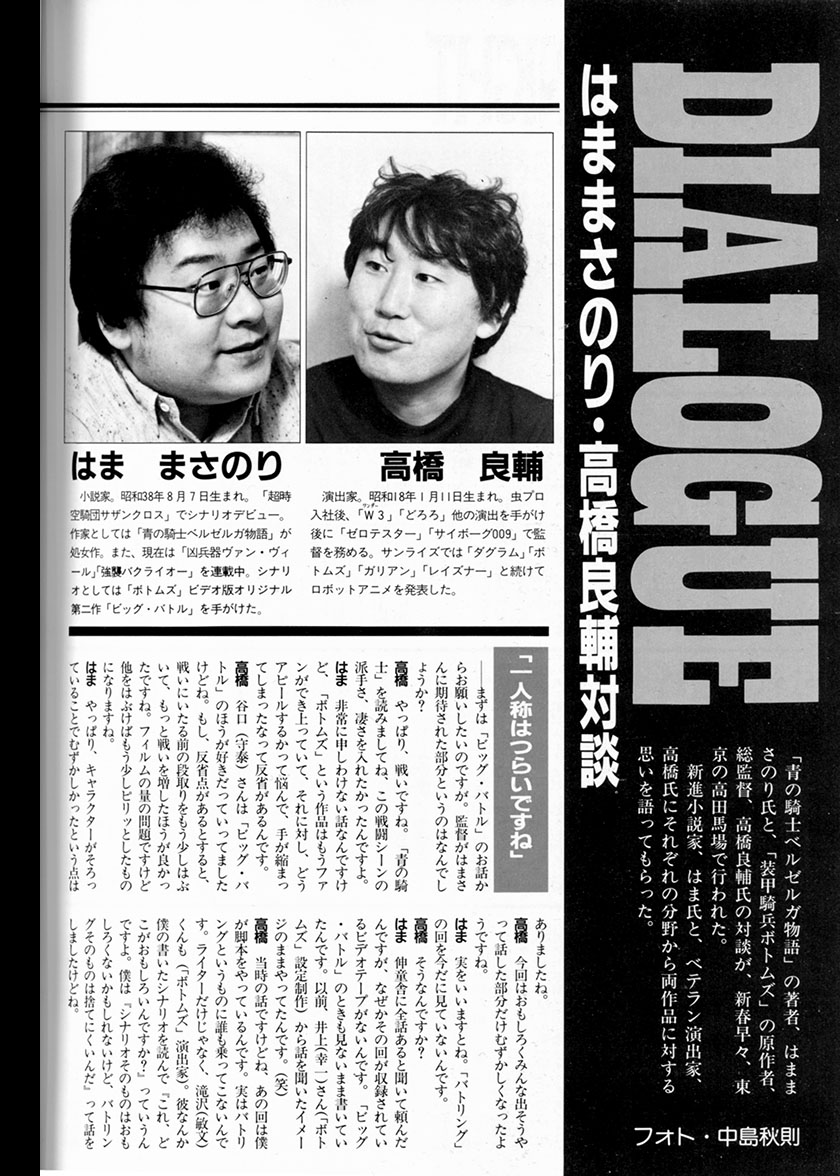
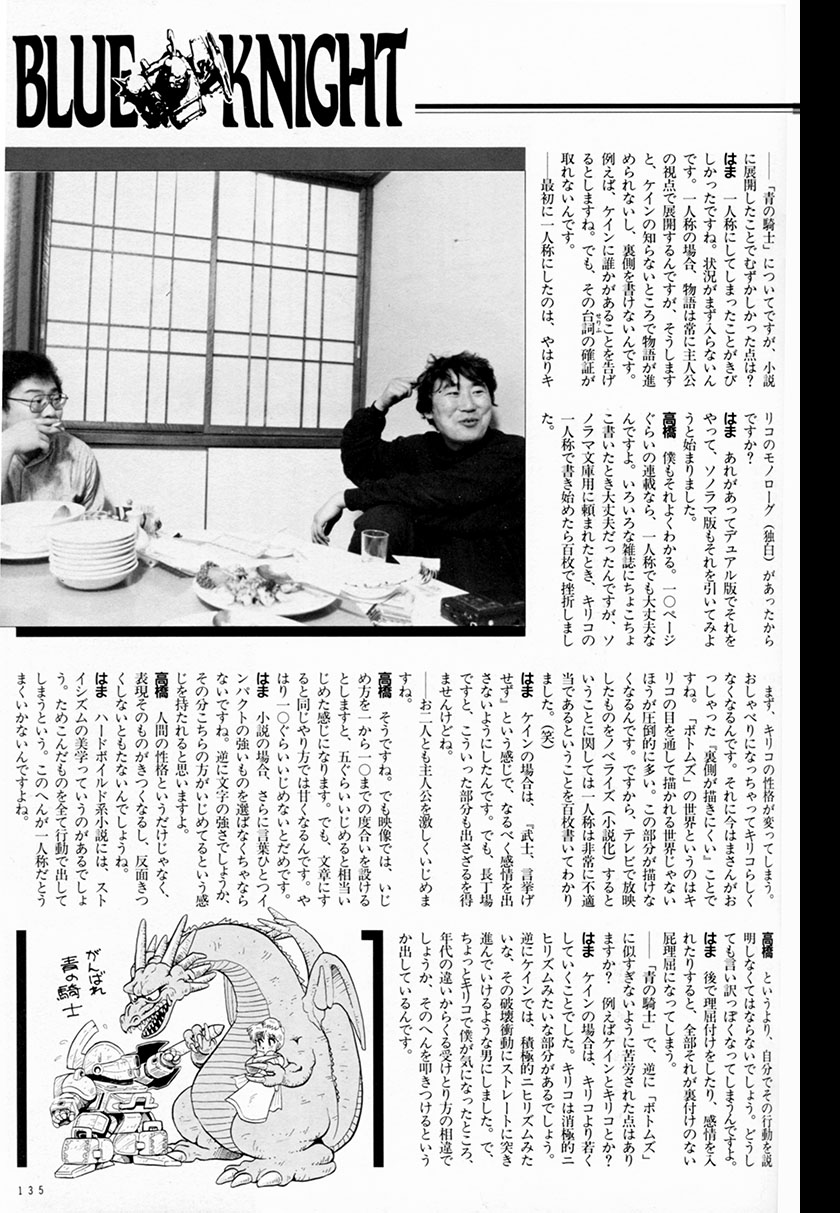
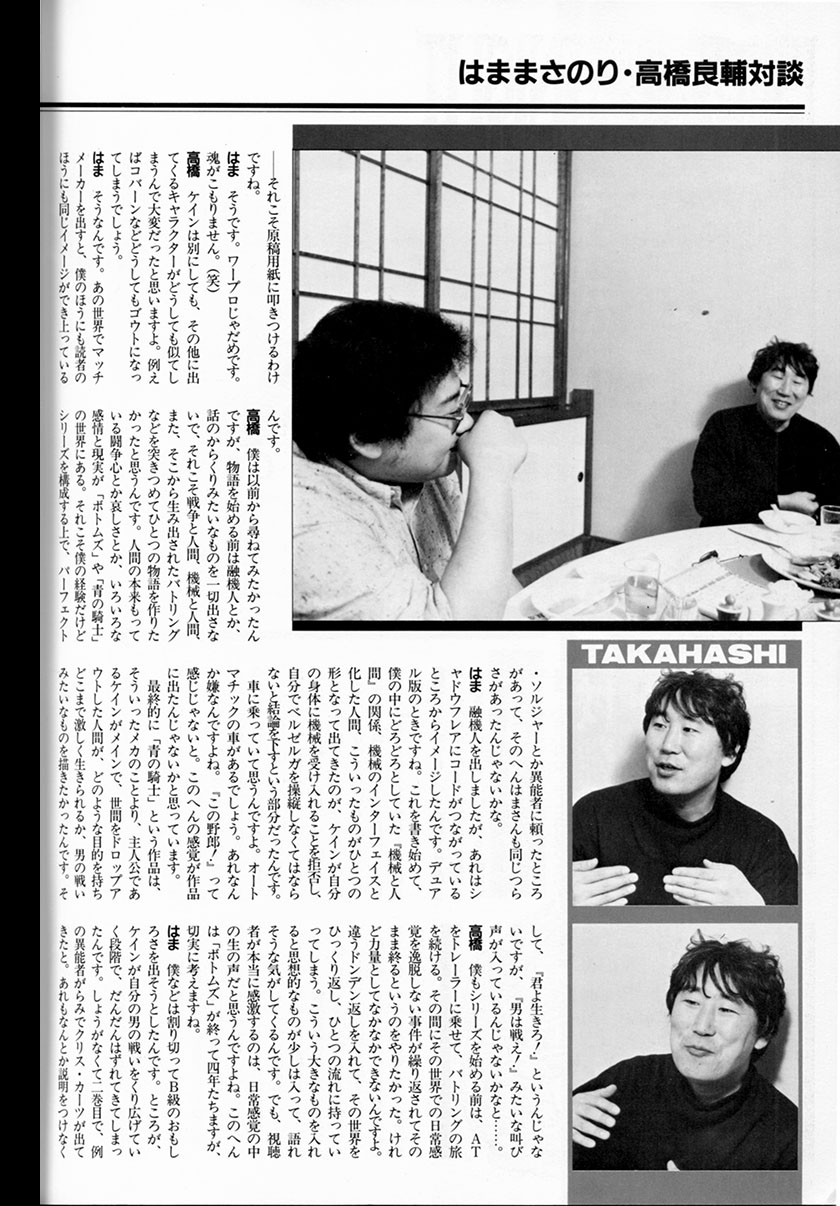
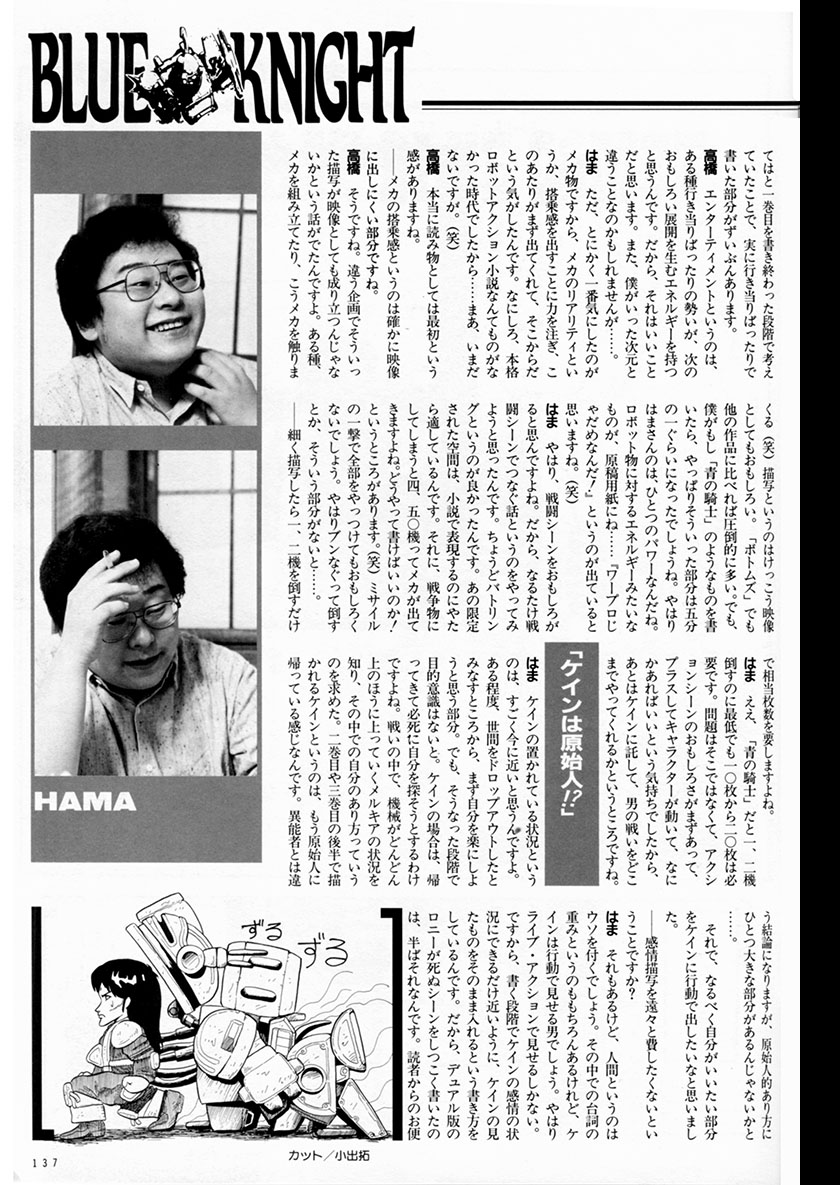
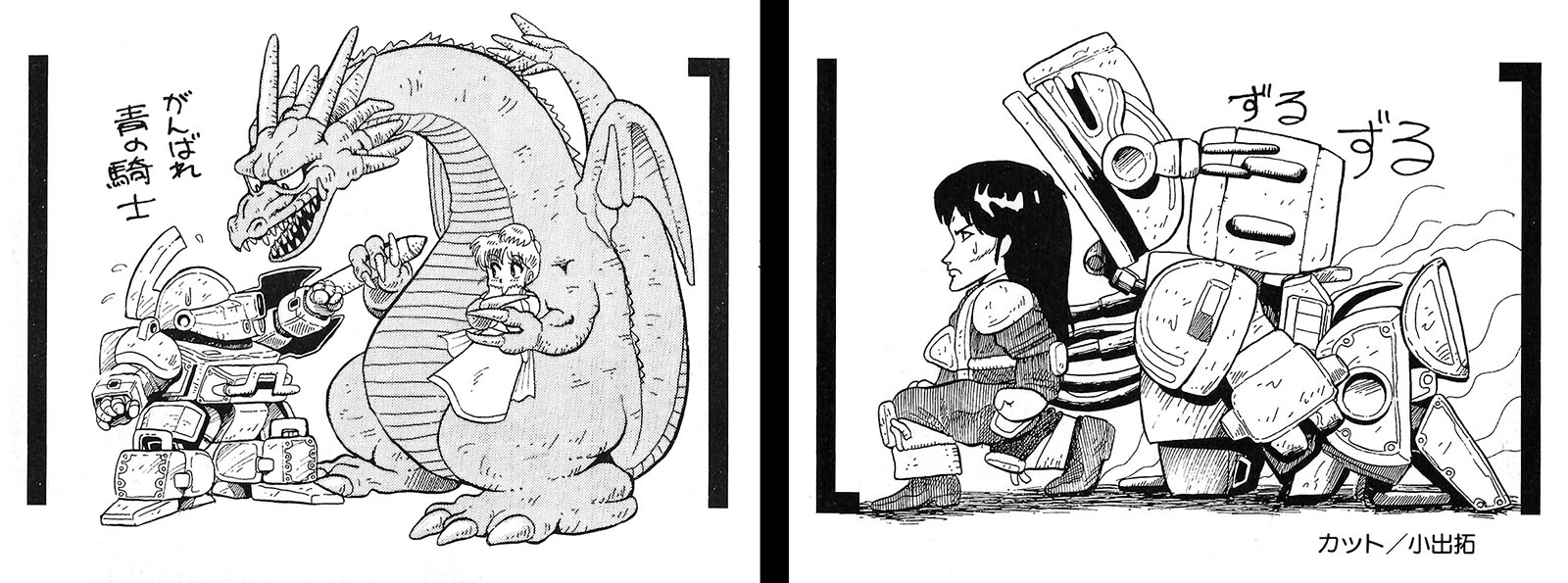
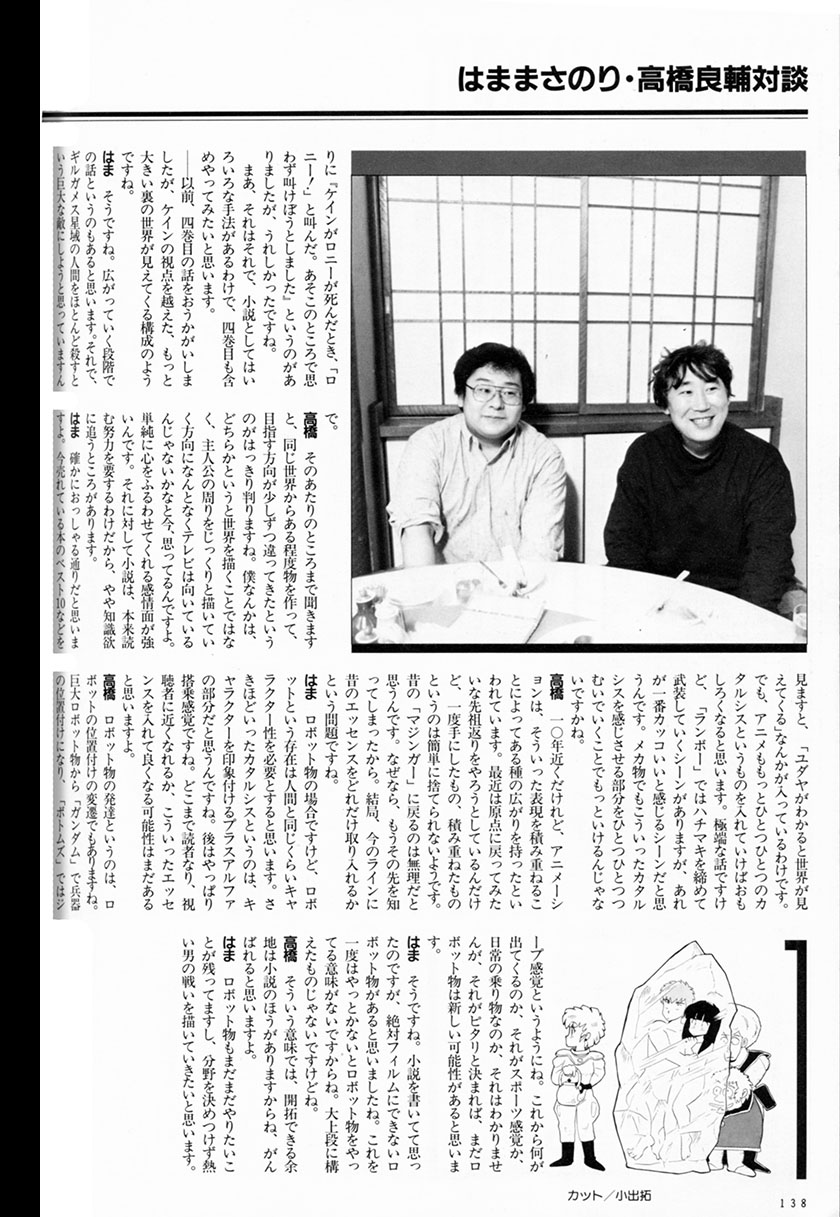
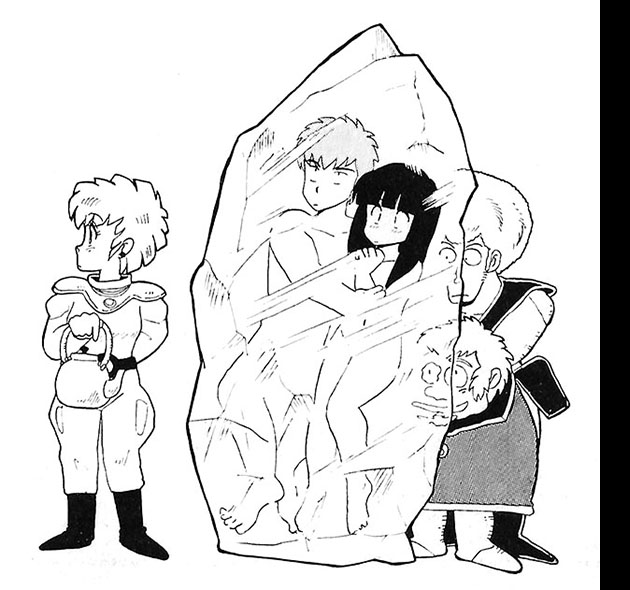
Haha, this is fascinating! Its like reading a battle between two authors over how to write a mecha story – one wants raw, brutal emotion, the other raw, brutal action. Takahashis bully the character up to 10 is gold, while Hamas focus on Kain as a caveman showing character through action makes perfect sense. And the word processor alone wont do line? Spot on! Its the soul, man, the soul. Plus, Hama needing 10-20 pages for a mecha fight? Thats comedy gold right there. Makes you appreciate the sheer effort (and occasional chaos) that goes into crafting these worlds!No, I’m not a Human
Haha, its fascinating hearing these creators talk about the struggles of writing mecha novels! Takahashis point about first-person being a bad fit for vast worlds like Votoms is spot on – Chiricos POV just couldnt contain it all! And Hamas manly battles approach to Kain sounds like a direct antidote to overwrought emotion, a refreshing dose of action-movie logic. Humans are capable of action like lies and their consequences, indeed – Kain shows character, loud and proud. It seems both series, despite different approaches, tapped into that core human fighting spirit, just with varying amounts of philosophical heavy lifting!free ai logo generator no watermark